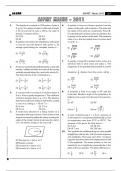Exam (elaborations)
Neet 2011 AIPMT mains exam question paper
- Course
- Institution
Description: The NEET Previous Year Questions PDF is a valuable resource for students preparing for the National Eligibility cum Entrance Test (NEET). It contains a compilation of authentic questions from previous years' NEET examinations.
[Show more]



